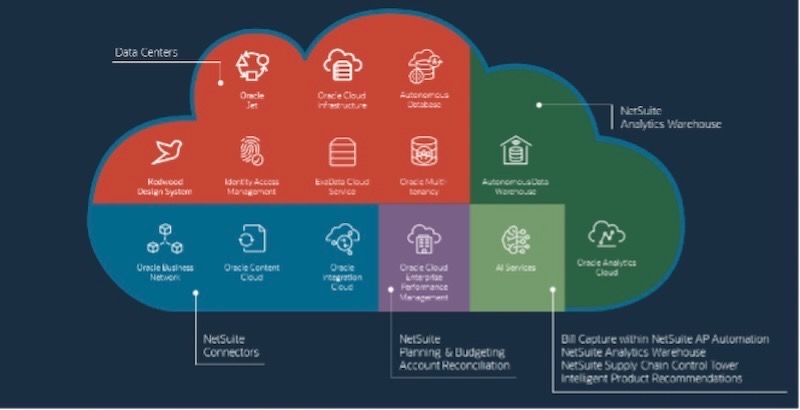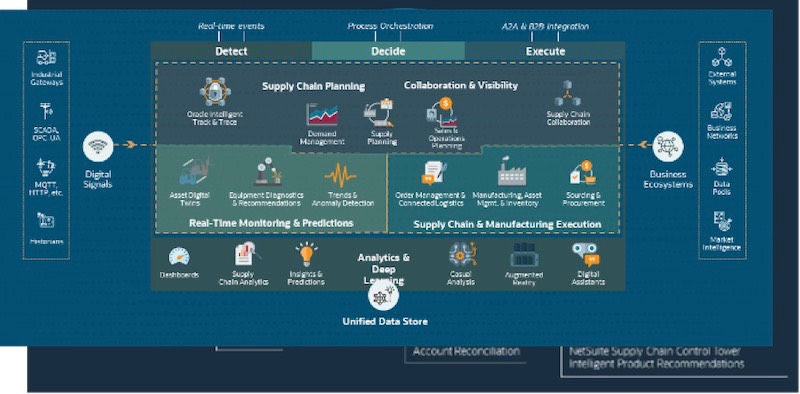Research was commissioned by the Aerospace & Defense PLM Action Group in collaboration with PTC and other leading PLM solution providers.
Key Takeaways
- The Oracle Applications & Industry Analyst Summit brought together senior leaders from across Oracle and industry analysts from a wide range of firms for a one-day event in Redwood Shores, CA.
- The event mainly focused on Oracle’s overall strategy, results, and key customer presentations, offering a nice update from Oracle CloudWorld in October 2022.
- Oracle is bringing more technology from their other enterprise offerings to their NetSuite portfolio, which is focused more on small- and medium-sized businesses.
- While Oracle rightfully touts offering the “most complete portfolio of applications and infrastructure,” they are investing heavily in new areas like the shop floor and lights-out manufacturing, which will provide data to feed their enhanced analytics and artificial intelligence capabilities.
CIMdata had the pleasure to attend the Oracle Applications & Industry Analyst Summit on April 25, 2023, in Redwood Shores, CA.[1] This one-day event brought together a large number of industry analysts representing a range of firms that cover different topics relevant to Oracle’s business and applications portfolio. The first half-day provided a broad view of Oracle and its strategic initiatives, including some focus on Oracle customers for the full audience. In the afternoon, the analysts splintered off into Industry Breakout sessions more aligned with respective coverage areas.
After a brief welcome by Mr. Simon Jones, Vice President of Analyst Relations and Public Relations, Mr. Steve Miranda, Oracle Executive Vice President for Applications Development, took the stage to provide an applications strategy update. They continue to move their company from a product company to a service company which, of course, impacts everything they do. Mr. Miranda described Oracle as having the “most complete portfolio of applications and infrastructure.” Their offerings do span from “chips to fingertips” as quipped by Mr. Larry Ellison, Oracle’s founder, Chairman, and CTO, at Oracle CloudWorld a few years ago. Their cloud infrastructure is powered by servers far evolved from their Sun acquisition in 2009. Oracle continues to expand that cloud infrastructure by adding data centers around the world. This infrastructure is accessible to customers primarily through Oracle Cloud Infrastructure (OCI), which is Oracle’s Infrastructure as a Service offering (IaaS). Their applications, many segment leaders, have been refashioned as part of their Fusion initiative to run natively on the cloud. The applications run on Oracle’s latest database technology, the dominant offering in that segment for decades.
Mr. Miranda also stressed the importance of their Redwood design system, the tools and templates used by Oracle’s developers to bring a new, consistent user experience (UX) across Oracle’s applications.[2] They are also making these tools, templates, and development guidance available to their partners and customers to ensure any extensions will provide the same UX. In an afternoon session, Mr. Jeff Price, Vice President of Product Management, shared a lot more details about how Oracle is enabling Redwood-based development. Those with the best intentions and tools can sometimes create poor UX. Perhaps Oracle can use their AI expertise to create a Redwood Advisor that assesses the UX of partner and customer applications according to their design philosophies. Just a thought.
This “new look and feel” is impressive and really highlights the potential benefits that their expanding analytics and artificial intelligence (AI) capabilities can bring to their customers. For several years CIMdata has emphasized the importance of “augmented intelligence” leveraging analytics and AI to bring actionable intelligence to the point of work. Oracle’s AI Platform for Business includes a range of capabilities to support this approach.
Mr. Miranda also provided an update on their “integrated services” capabilities with JP Morgan in banking and FedEx in logistics.[3] These companies run on Oracle Cloud Infrastructure, as do many of their customers. Those customers can transact with JP Morgan and FedEx essentially directly from their applications to those of JP Morgan and FedEx, disintermediating all of processes, paperwork, and human action. It is an interesting idea, one that Oracle expands to other global companies. For example, DHL and UPS are also Oracle customers. Mr. Miranda stated that more integrated services partners will be announced at Oracle CloudWorld in September.
Mr. Evan Goldberg, Executive Vice President, NetSuite (and company founder), was next up, a welcome development. The focus in analyst events is more on Oracle’s core enterprise offerings, not NetSuite, which is focused more on the midmarket and smaller businesses. Their cloud-native business platform exploded into a strong position in that segment, leading to NetSuite’s purchase by Oracle in 2016. NetSuite customers are benefitting from Oracle technologies as shown in Figure 1, below.

Figure 1--Oracle Technologies Enhancing NetSuite Value
(Courtesy of Oracle)
The application is optimized for the Oracle Cloud Infrastructure (OCI) and Oracle Autonomous Database. The NetSuite Analytics Warehouse leverages the Oracle Analytics Cloud and the Oracle Data Warehouse, also optimized for NetSuite. Bringing actionable intelligence to the point of work is even more important to the small- and medium-sized businesses targeted by NetSuite who may lack the resources to implement analytics and AI offerings themselves.
Mr. Gary Miller, Oracle Customer Success Officer (their first), described their new Customer Success Services Organization. Oracle is standardizing services globally and bringing together several existing organizational units to create this new organization. The notion of customer success in software companies dates back to the mid-1990s[4] but the concept is simple. It is not enough to just sell to a customer, the job of the “sales” organization. Yes, a one-time sale provides revenue but happy and successful customers will come back for more. In this age of digital transformation customers need strategic partners to help them achieve their strategic objectives. CIMdata has seen this approach work at other software firms and expects it to work with Oracle too. It is also an important part of their move from a product to a service organization as noted by Mr. Miranda. Oracle intends to share more information on this topic after their June earnings announcement.

Figure 2--The Oracle Supply Chain Management (SCM) Cloud
(Courtesy of Oracle)
CIMdata attended the Industry Breakout focused on supply chain, the home within Oracle for their product lifecycle management (PLM) offerings and much more, of course. Figure 2 illustrates the span of Oracle’s supply chain vision and offerings. This figure highlights the foundational importance of analytics and deep learning to their approach. Oracle has always had extensive supply chain capabilities but at this event there was more emphasis on Industry 4.0 and advanced manufacturing. Oracle is working hard to extend their reach down to the shop floor to Industrial Internet of Things (IIoT) use cases. Their IIoT-enabled smart manufacturing vision includes connections to the factory floor to capture real-time status of manufacturing operations. This is an important part of the digital thread but shop floor specialists like Siemens and Hexagon, among others, focus on this area and Oracle will have to build a strong team to succeed. Their plan to support lights-out manufacturing leverages a number of existing Oracle offerings but a lot of work remains.
Conclusion
This commentary only touches on the content delivered by Oracle to the convened analysts. There were in-depth sessions on analytics and Oracle’s industry strategy. Oracle delivered a session on Investments for Good which focused on Oracle’s environmental actions and targets as a company and how they are helping their customers meet their Environmental, Societal, and Governance (ESG) objectives. But the overall message from the days agenda was the breadth and depth that Oracle offers.
Of course, that was always true but the message was delivered a bit differently at this event than it was at Oracle CloudWorld last September. The title of the CIMdata commentary for that event was “The Future is Multi-Cloud,” a recognition that many industrial companies will rely on multiple cloud infrastructure providers to implement their information technology landscapes. It was also acknowledged that the application landscape would be heterogeneous as well.
In contrast, in multiple sessions at the analyst summit, there was a three-point description of Oracle’s approach: complete end-to-end solutions; innovations that matter; and committed to customer success. The notion of Oracle as a one stop shop was stronger than at recent events, with less emphasis on supporting heterogeneous application landscapes. It could be just our perception from the event. Yes, Oracle can provide better support in many cases by supplying the full stack of applications. But we know from our industrial consulting work that many customers want heterogeneity. Sales teams will need to tread lightly at these prospects to ensure they can best support the customers’ vision.
Oracle previewed a range of topics at this event, as cited in this commentary, and CIMdata looks forward to learning more about Oracle’s expansive plans and results to date in their coming earnings calls and at CloudWorld in September.
[1] Research for this commentary was partially supported by Oracle.
[2] At the event, CIMdata noticed that Oracle’s slide templates and graphics had changed significantly, with a more updated look. Oracle confirmed that having the Redwood “design community” embedded in the company had brought their design expertise to their collateral development process. CIMdata has seen this occur at other software companies who also took this approach to UX.
[3] There is more detail on this topic in https://www.cimdata.com/en/resources/complimentary-reports-research/commentaries/item/20248-the-future-is-multi-cloud-oracle-cloudworld-2022-commentary.
[4] https://www.customersuccessassociation.com/library/the-history-of-customer-success-part-1/







